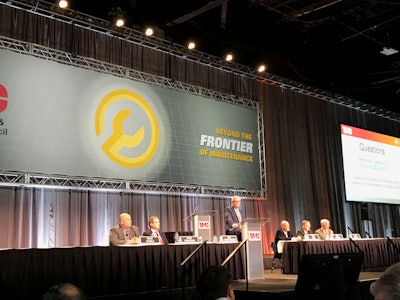 Active vehicle safety systems took center stage during Monday’s first technical session at TMC in Atlanta.
Active vehicle safety systems took center stage during Monday’s first technical session at TMC in Atlanta.The take rates of active vehicle safety systems have risen steadily over the last five years as the technology has advanced and fleet interest has grown. But despite that growing acceptance, both fleets and manufacturers note implementation of these systems is rarely seamless. Plug-and-play as they may seem, advanced vehicle safety technologies represent a significant adjustment to a driver’s workspace.
During a technical session Tuesday at ATA’s Technology & Maintenance Council (TMC) Annual Meeting in Atlanta, representatives from Bendix, Detroit, WABCO and two large fleets shared their thoughts and best practices on implementing advanced vehicle safety systems to ensure driver buy-in and maximize the capabilities of such equipment.
“I know most of you have this technology today. Do your drivers like it?” Bendix’s Brad Allen asked the fleets in attendance during Tuesday’s session. Allen says today’s active vehicle safety systems are built to aid drivers. Every advancement is designed to make drivers safer, more effective and reduce the likelihood they are involved in a collision. He says when that is properly communicated to drivers — so they truly understand why their workspace has become a beeping, flashing experience — they are receptive. They want to be safe. But when that information isn’t communicated? “That’s when you get tampering,” Allen says.
Chris Reynolds with Southeastern Freight lines says tampering is devastating not only because it reduces the capabilities of the systems, but also because it shows a disconnect between a fleet’s decision making and communication with its employees.
He says Southeastern Freight Lines has developed a structured training process it uses when rolling out new tech advancements to ensure drivers are properly alerted to any changes. He says an advanced technology’s biggest supporter is an engaged driver — someone who has experienced the safety technology first hand or, ideally, been shown examples of how driver assistance tools will make them safer. He says the ROI on these systems is fantastic when they are used properly.
“It only takes one [close call] to pay for a system,” he says.
At Covenant Transport, Rick Reinoehl says his company was forced to implement a zero-tolerance policy regarding driver tampering. He says it forced the company to remove a few drivers, but (with comprehensive training) also helped the rest of its driver population better understand why the company has invested so much in this technology. He also says Covenant Transport has opened its doors to driver complaints. The better the organization understands why drivers are frustrated, the more likely it can develop a solution that appeases them, Reinoehl says.
For what it’s worth, manufacturers say they continue to alter and enhance the technologies to make them more intuitive to users. Says WABCO’s Doug Donaldson, manufacturers want to “assist the driver without him even knowing it.”
Detroit’s Brian Daniels agrees, saying today’s advanced vehicle safety systems “are supposed to supplement the driver.”












